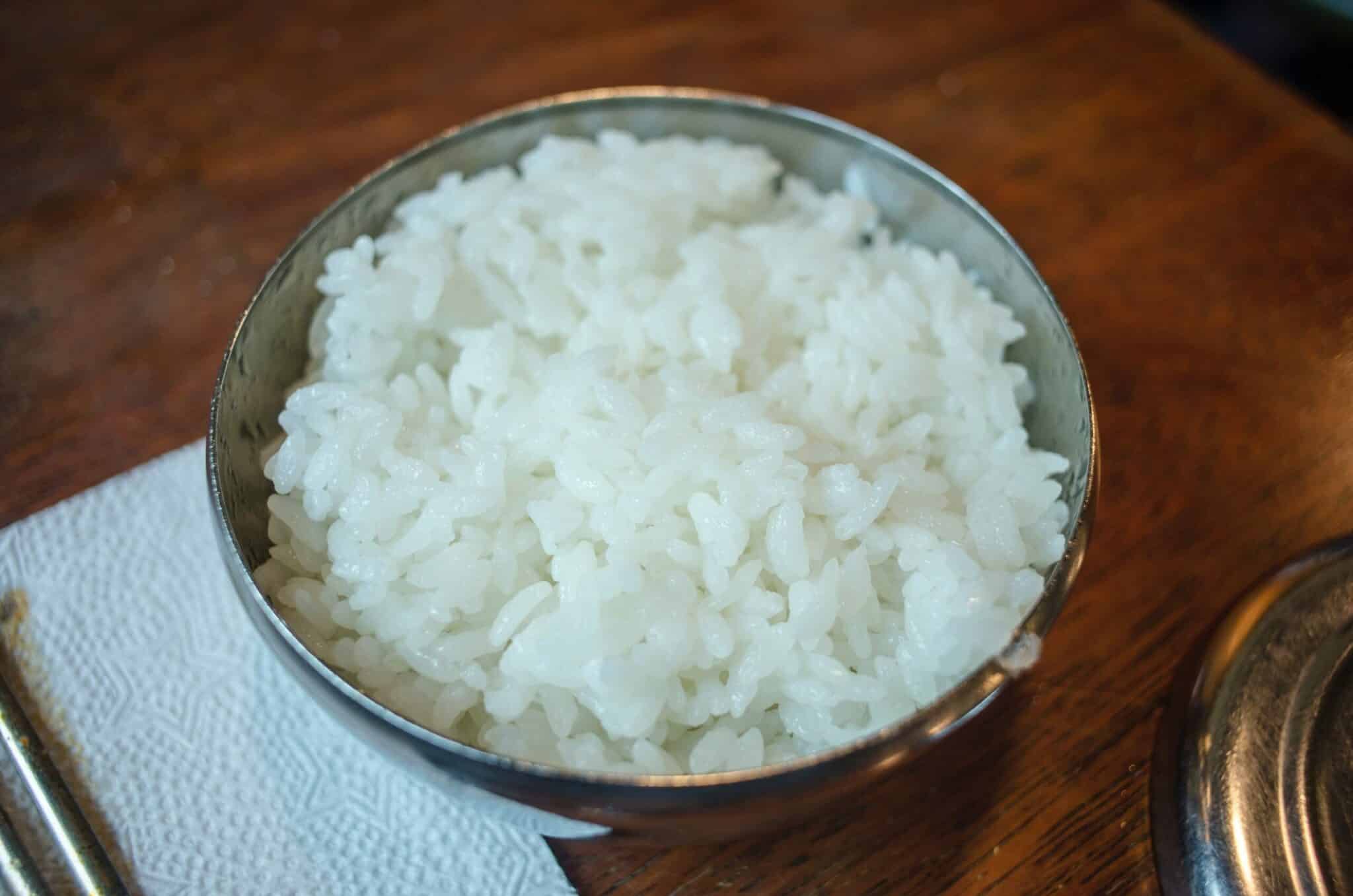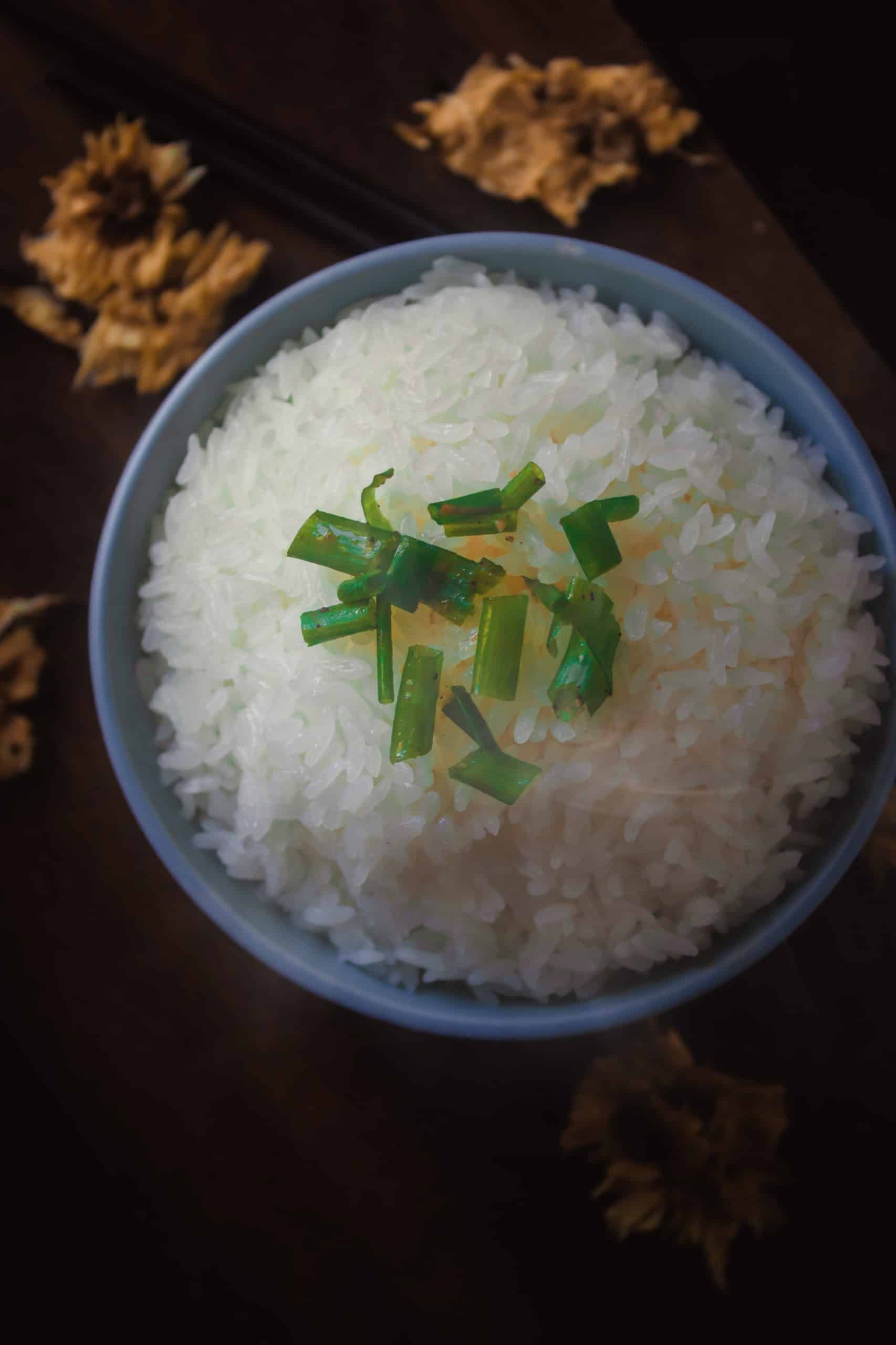White Rice is a versatile ingredient that may be used to make a nutritious, low-effort side dish or a wonderful main dish. Adding butter or sesame oil to your white rice will enhance the flavor and nutrition of the dish. There are various ways to season and cook rice to make it taste excellent without spending much time in the kitchen.

To improve the flavor of white rice, use a range of spices and herbs. Before cooking your white rice, add a pinch of turmeric or bay leaves to bring out its natural taste. Add a cinnamon stick after the rice has finished cooking to add a more aromatic flavor. Use a combination of veggie broth, butter, and spices to get the greatest taste out of your white grain. Try this taste combo to turn your boring rice into something everyone will like!
What does white rice taste like?
Rice that has been milled and has had its husk, bran, and germ removed is white rice. Rice’s taste, texture, and appearance are all altered due to this process, which also helps prevent spoiling, extends the rice’s storage life, and makes it simpler to digest. The rice is polished after milling, also known as hulling, which leaves the seed with a brilliant, white, and lustrous look.
Nutrients are removed during the milling and polishing procedures. Because of a thiamine shortage caused by an unbalanced diet centered on unenriched white rice, many people are susceptible to beriberi’s neurological disorder (vitamin B1). Some of the nutrients removed from white rice during processing are often reintroduced.
White Rice has a distinct flavor and texture, and white rice has a softer, more delicate texture and a milder flavor. Because the starchiest section of the grain is revealed during the milling process, it is starchier and has a stickier feel than Brown Rice. White Rice is, therefore, easier to consume with chopsticks. Because of its mild flavor and smooth texture, white rice pairs well with delicately flavored components and recipes.
How to make white rice taste better?
Rice is excellent when served with Mexican cuisine, but it never tastes quite as indulgent when made at home. Fortunately, there are a variety of techniques to make white rice taste nice that don’t take a long time or require advanced cooking abilities. Your favorite grain has just gotten a lot better.
White Rice is a flexible side dish that goes well with everything from Cajun-style red beans to Chinese stir-fry. When you’re in a rush, don’t rely on freezer dinners or takeaway – this starch can be cooked and made even more wonderful in 15 minutes. To transform your sad pot of rice into rad, all you need is a well-stocked pantry, a solid spice rack, and a little bit of imagination. There’s no need to worry about dinnertime; simply put a pot on the stovetop and start cooking.
Here are some ways to make white rice taste better:
The first step in improving the flavor of white rice is to thoroughly rinse it. Excess starch will be removed, and uneven cooking will be avoided. After that, add some veggies or vegetable broth to the rice. If you want less buttery rice, use extra virgin olive oil instead of butter. Serve with parsley or any green garnish on top of your rice. Adding spices and herbs to plain white rice is the best method to make it more interesting.
1. Enriched rice
The brownish bran layer of white rice has been removed, leaving the light, fluffy starch grains intact. While this technique speeds up the cooking time of white rice, it also removes some of the nourishment from the whole grain. Enrichment is a key component of making healthy rice meals because it replaces these nutrients. While iron, folic acid, thiamin, and riboflavin are all present in enhanced rice, it does not have a distinct flavor. Calcium and vitamin D are also present in some fortified rice varieties. Manufacturers spray the grains with a thin coating of these nutrients to enrich the rice. Before cooking, don’t rinse enhanced rice to prevent vitamins and minerals from being washed away.
2. Stock or broth
Replace the water in a simple rice bowl with stock as the cooking liquid. Rice gets a deep flavor from stock, a tasty liquid made from bones and aromatic vegetables that have been simmered without adding fat or calories. Choose vegetable broth as a cooking medium if you want a vegetarian or vegan version. You may also use the water left over after blanching or steaming veggies as the rice cooking liquid, but keep an eye on the sodium content because the salt from the steamed vegetables may end up in the rice, making the meal overly salty.
3. Spices and herbs
Whether fresh or dried, Herbs add flavor to a dish while keeping fat and sodium levels low. Rice’s neutral flavor complements a wide range of flavors and cooking styles. It has a Spanish flavor thanks to the saffron and oregano and a Vietnamese flavor thanks to the ginger and cilantro. When paired with cinnamon, cardamom, nutmeg, and cloves, plain white rice can become a delectable delight from the previous night.
4. Mock risotto
While chefs prefer Italian arborio rice for real risotto due to its high starch content, plain white rice can be cooked similarly for a tasty side dish. Risotto begins with broth or stock but gradually adds the boiling liquid to make the dish creamy rather than light and fluffy like plain white rice. Many traditional risotto recipes call for butter, but you can get the same flavor without the saturated fat by using olive oil instead. Start with diced onions or shallots and finish with grated Parmesan, minced chives, or crumbled walnuts to add different levels of flavor. While white rice may not turn as creamy as arborio rice in a simple risotto, it will have a notably rich texture when cooked with hot stock. Mushrooms, zucchini, or spinach add nutrition and flavor to your faux risotto.
If you’re making plain white rice, you might want to try adding some butter. The residual heat will aid in the melting of the butter. Use three tablespoons of butter if you want your rice to be more buttery, or two if you want it to be less buttery. Instead of butter, you can use extra virgin olive oil. Top it with parsley or some other green garnish when the rice is done.
If you want to serve white rice more healthily, add a few extra things. Coconut cream or coconut milk makes a delicious non-dairy rice accompaniment, and it will be especially sweet if you add a few tablespoons. You can use half of the liquid in your recipe instead of the sweet coconut cream. Serve your rice after you’ve added your spices and herbs.
Health benefits of white rice
1. It’s a convenient source of energy
White Rice is a simpler carbohydrate since it lacks the bran and germ and the fiber and fat content that comes with it. As a result, your body has an easier time breaking it down, which permits nutrients, particularly carbs, to be absorbed more quickly. As a result, white rice is an excellent choice for people who require a quick energy source, such as athletes or anyone who engages in a prolonged workout or any activity.
2. It’s simple to digest
Complex carbs’ fiber, protein, and fat levels may be difficult to digest for people with specific digestive disorders. While they may not be able to consume brown rice or other whole grains during a flare-up due to painful bloating and inflammation, they can eat readily digested white rice. Even if you don’t have a recognized digestive issue, white rice can help if you’re suffering from a severe case of diarrhea.
3. It’s reassuring
Who doesn’t enjoy a warm bowl of white rice? It’s tasty and soothing whether topped with curry, kimchi, roasted vegetables, or a little butter and salt. There’s also something to be said about the health advantages of eating your favorite comfort foods—think happier feelings and less stress. So make it the next time you have a hankering for it and enjoy it.
4. It’s accessible
White Rice is often less expensive than its whole-grain alternatives, making it more accessible to individuals from all walks of life. White Rice may be one of the only grains available at corner stores or bodegas in places where healthier food options are scarce. We can encourage people to match this easy-to-make, versatile grain with other nutritious items to create a healthy dinner by refuting the myth that white rice is bad.
5. It’s free of gluten
Rice is a hypoallergenic food beneficial to gluten-intolerant persons who suffer from celiac disease. Rice is a gluten-free grain that may be easily transformed into flour, noodles, and bread for those seeking gluten-free options.
What’s the difference between brown and white rice?
White Rice is Rice that has had its bran (fibrous outer layer) and germ (nutritious core) removed during processing, giving it a distinct taste, texture, color, and nutritional breakdown to Brown Rice. As a result, it’s not surprising that the nutritional content of white rice differs from that of brown rice, as seen below.
White rice nutrition
Here’s how 1 cup of cooked long-grain enhanced white rice stacks up nutritionally:
- 205 calories
- 28g carbohydrates
- 6g fiber
- 4g protein
- 4g fat
Brown rice nutrition
Here’s how 1 cup of cooked long-grain enhanced brown rice stacks up nutritionally:
- 248 calories
- 52g carbohydrate
- 3g fiber
- 6g protein
- 2g fat
What is a good rice seasoning?
Rice that has been seasoned with garlic powder results in a flavorful side dish that is versatile and goes well with many different kinds of dishes. According to Bon Appetit, garlic powder also contributes a wonderful umami note to the dish. If you are looking for something a bit different, you could use cardamom, cumin, cinnamon, or even a combination.
With white rice, what do you eat?
7 Yummy White Rice Side Dishes
- Burritos
- Salad
- Lettuce Wraps are a delicious way to eat lettuce
- Soup
- Vegetables
- Fruits
- The Good Stuff
Is it okay to consume rice daily?
While we are not talking about dangerous amounts in a single serving or anything alarming, it is not a good idea to consume rice multiple times a day (daily). Arsenic exposure in excess has been related to an elevated risk of developing heart disease and certain types of cancer.
Conclusion
There are numerous techniques to improve the flavor of white rice. After you’ve finished cooking the rice, an easy approach is to add butter to it. If you like a butterier version of the meal, use extra virgin olive oil instead of butter. You can also season your white rice with herbs and spices. You can serve the dish with a smile on your face once you’ve added all of the necessary ingredients.
